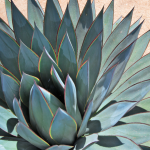Agaves are succulent plants known for their architectural beauty and versatility.
They are native to the Americas, particularly Mexico, and are known for their long, fleshy leaves and striking shapes. There are over 200 species of agave, each with unique characteristics that make them ideal for different landscapes, climates, and design styles. In this blog post, we will explore some of the most popular types of agaves and their distinct features.
Agave Americana
Agave Americana, also known as the Century Plant, is one of the largest species of agave, with leaves that can grow up to 6 feet long. Its striking blue-green color and spiky edges make it a popular choice for xeriscaping, as it requires little water and is tolerant of hot, dry conditions.
Agave Victoriae-Reginae
Agave Victoriae-Reginae, also known as the Queen Victoria Agave, is a smaller species that is prized for its symmetrical, white-striped leaves. It is a slow-growing plant that requires plenty of sunlight and well-drained soil, making it ideal for rock gardens and desert landscapes.
Agave Attenuata
Agave Attenuata, also known as the Foxtail Agave, is a popular species for landscaping due to its lack of sharp spines and softer leaves. Its smooth, flowing shape and pale blue-green color make it a great choice for tropical or coastal gardens.
Agave Parryi
Agave Parryi, also known as the Artichoke Agave, is a smaller, more compact species with distinctive rounded leaves that resemble an artichoke. It is tolerant of a wide range of temperatures and can be grown in both arid and humid environments.
Agave Tequilana
Agave Tequilana, also known as the Blue Agave, is perhaps the most well-known species due to its use in tequila production. It has long, sharp leaves that are a silvery blue color and can grow up to 8 feet tall. It requires plenty of sunlight and well-drained soil, making it ideal for warmer, drier climates.
Agaves are a diverse and fascinating group of plants that offer a wide range of benefits to gardeners, landscapers, and plant enthusiasts alike. By understanding the unique characteristics of each species, you can choose the perfect agave for your specific needs and create a stunning, low-maintenance landscape that is sure to impress.





